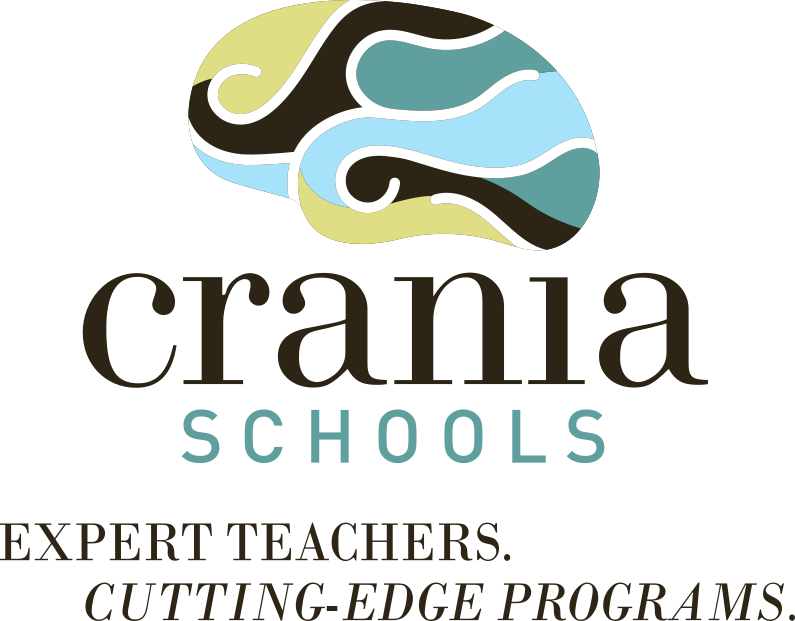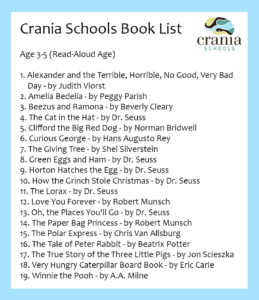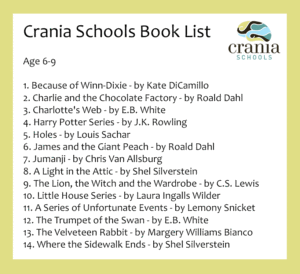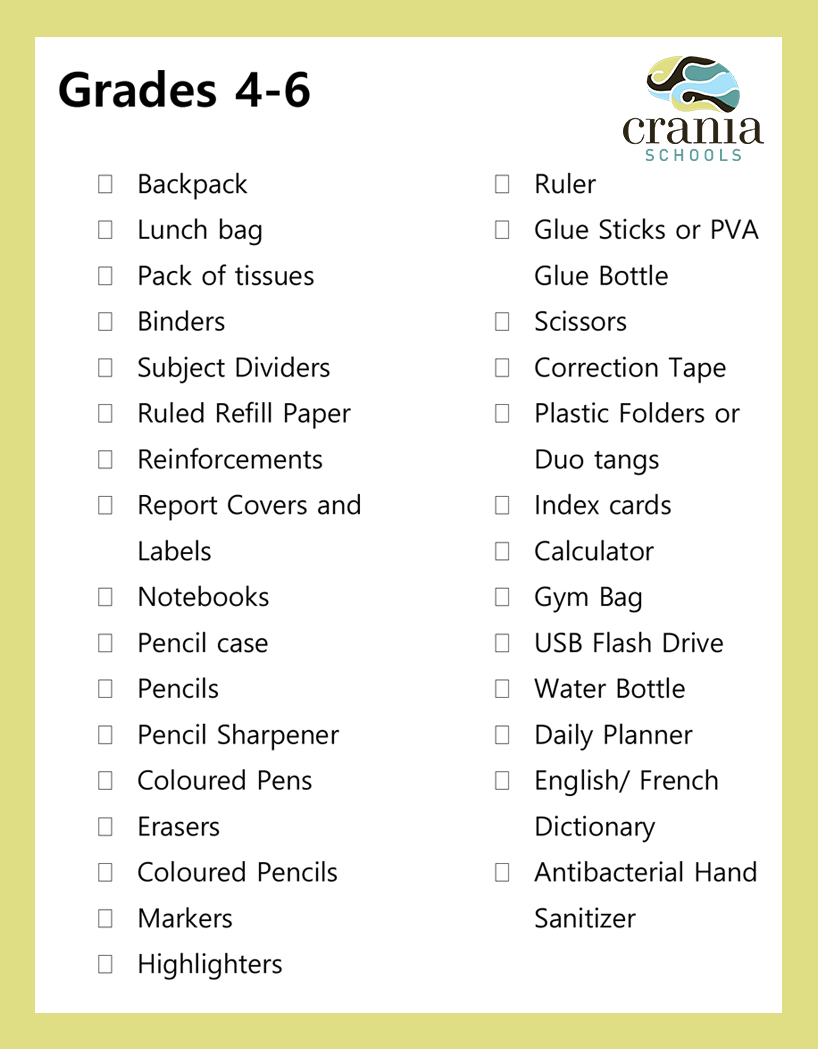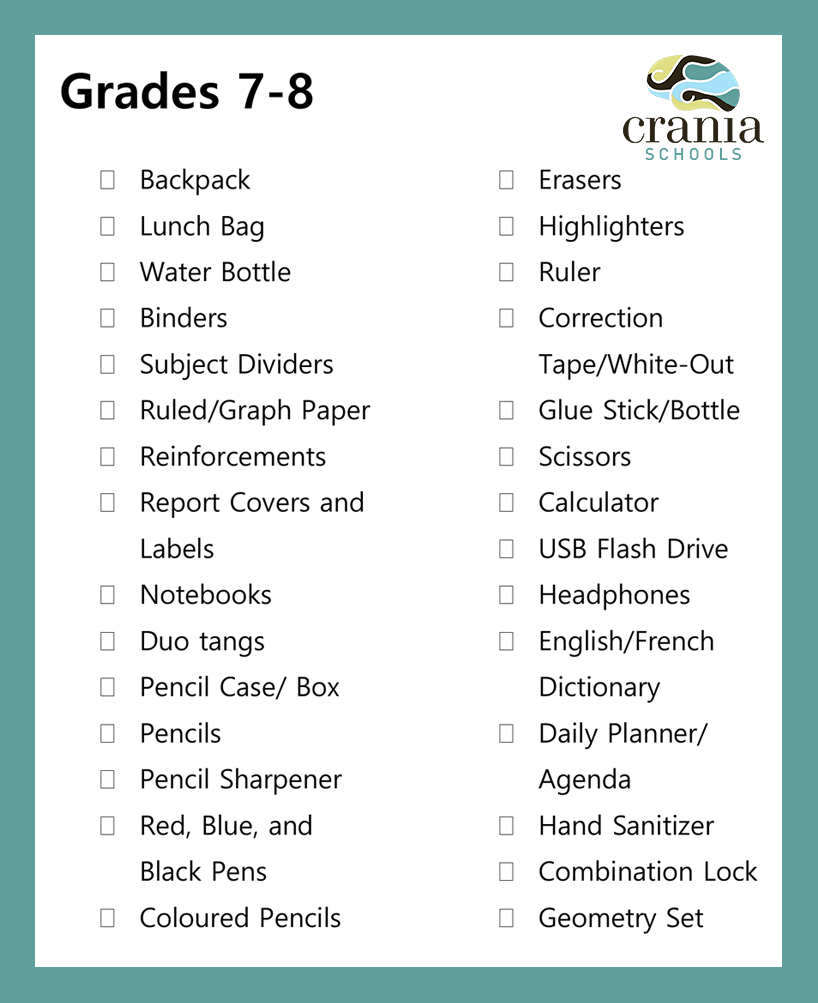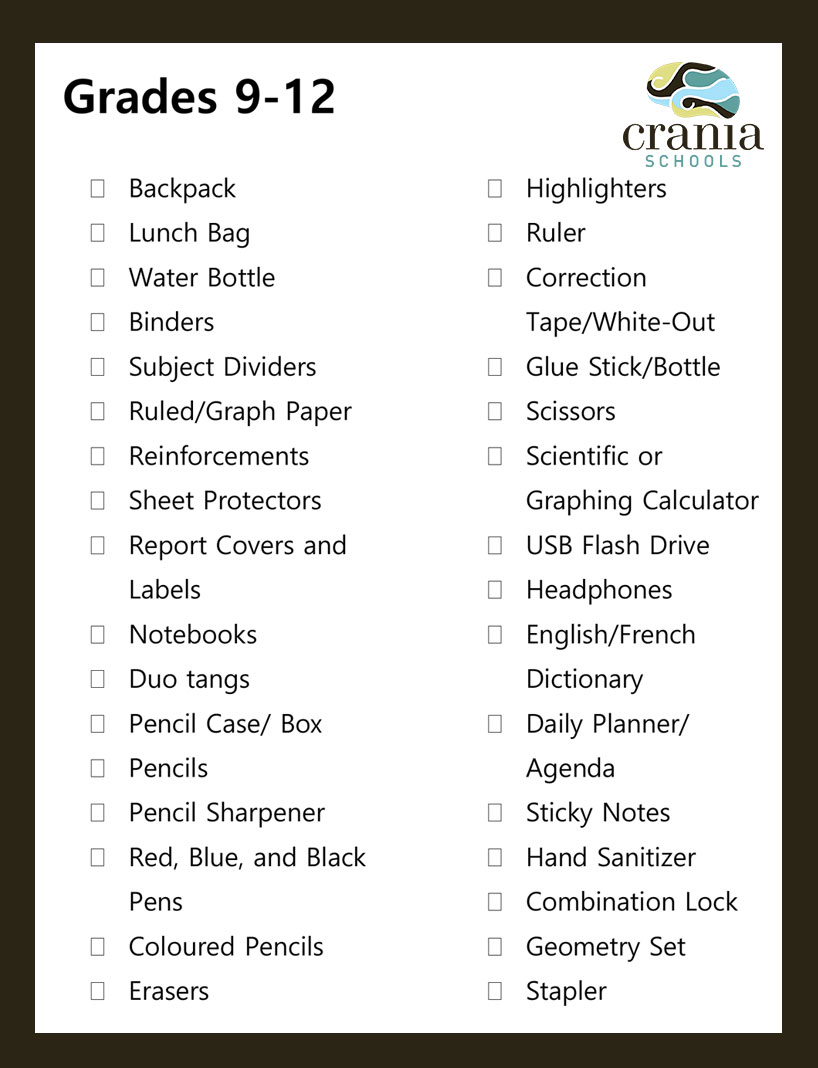Global Education Rankings (2022)

How Does Your Child’s Education Stand Up Globally? The results were just released in December 2023.
The Programme for International Student Assessment (PISA) is an international assessment conducted by the Organisation for Economic Co-operation and Development (OECD) that aims to answer this very question. PISA evaluates and compares the performance of 15-year-old students in reading, mathematics, and science across countries. The assessment is conducted every three years, and it provides valuable insights into how well education systems are preparing students for future challenges.
Key features of the PISA test include:
- Focus on Real-World Skills: PISA assesses students’ ability to apply their knowledge and skills to real-world problems and scenarios, emphasizing the application of knowledge rather than rote memorization.
- Rotational Design: PISA employs a rotational design, meaning that not all students take the same test. Instead, each participating country tests a sample of students in one or more of the assessed subjects, allowing for a broad coverage of skills and knowledge.
- Cross-Disciplinary Assessment: PISA recognizes the interconnected nature of knowledge and skills. For example, the reading assessment may include tasks that involve interpreting information related to science or mathematics.
- International Comparison: One of the primary purposes of PISA is to compare educational outcomes across countries. The results help policymakers understand how their education systems perform relative to others and identify areas for improvement.
- Questionnaire Surveys: In addition to the test items, PISA includes questionnaires that gather information from students, teachers, and school principals. These questionnaires provide context and additional insights into the factors that may influence student performance.
PISA does not assess the entire curriculum of participating countries but focuses on a subset of skills that are considered essential for success in the modern world. The results of the assessment are widely used to inform education policy and practice globally.
Here are the results1:
| MATHEMATICS | READING | SCIENCE |
| 1. Singapore 2. Macao (China) 3. Chinese Taipei 4. Hong Kong (China) 5. Japan 6. Korea 7. Estonia 8. Switzerland 9. Canada 10. Netherlands 11. Ireland 12. Belgium 13. Denmark 14. United Kingdom 15. Poland 16. Austria 17. Australia 18. Czech Republic 19. Slovenia 20. Finland 21. Latvia 22. Sweden 23. New Zealand 24. Lithuania 25. Germany 26. France 27. Spain 28. Hungary 29. Portugal 30. Italy 31. Viet Nam 32. Norway 33. Malta 34. United States 35. Slovak Republic 36. Croatia 37. Iceland 38. Israel 39. Türkiye 40. Brunei Darussalam 41. Ukrainian regions (18/27) 42. Serbia 43. United Arab Emirates 44. Greece 45. Romania 46. Kazakhstan 47. Mongolia 48. Cyprus 49. Bulgaria 50. Moldova 51. Qatar 52. Chile 53. Uruguay 54. Malaysia 55. Montenegro 56. Baku (Azerbaijan) 57. Mexico 58. Thailand 59. Peru 60. Georgia 61. Saudi Arabia 62. North Macedonia 63. Costa Rica 64. Colombia 65. Brazil 66. Argentina 67. Jamaica 68. Albania 69. Palestinian Authority 70. Indonesia 71. Morocco 72. Uzbekistan 73. Jordan 74. Panama 75. Kosovo 76. Philippines 77. Guatemala 78. El Salvador 78. Dominican Republic 80. Paraguay 81. Cambodia | 1. Singapore 2. Ireland 3. Japan 4. Korea 5. Chinese Taipei 6. Estonia 7. Macao (China) 8. Canada 9. United States 10. New Zealand 11. Hong Kong (China) 12. Australia 13. United Kingdom 14. Finland 15. Denmark 16. Poland 17. Czech Republic 18. Sweden 19. Switzerland 20. Italy 21. Austria 22. Germany 23. Belgium 24. Portugal 25. Norway 26. Croatia 27. Latvia 28. Spain 29. France 30. Israel 31. Hungary 32. Lithuania 33. Slovenia 34. Viet Nam 35. Netherlands 36. Türkiye 37. Chile 38. Slovak Republic 39. Malta 40. Serbia 41. Greece 42. Iceland 43. Uruguay 44. Brunei Darussalam 45. Romania 46. Ukrainian regions (18/27) 47. Qatar 48. United Arab Emirates 49. Mexico 50. Costa Rica 51. Moldova 52. Brazil 53. Jamaica 54. Colombia 55. Peru 56. Montenegro 57. Bulgaria 58. Argentina 59. Panama 60. Malaysia 61. Kazakhstan 62. Saudi Arabia 63. Cyprus 64. Thailand 65. Mongolia 66. Guatemala 67. Georgia 68. Paraguay 69. Baku (Azerbaijan) 70. El Salvador 71. Indonesia 72. North Macedonia 73. Albania 74. Dominican Republic 75. Palestinian Authority 76. Philippines 77. Kosovo 78. Jordan 79. Morocco 80. Uzbekistan 81. Cambodia | 1. Singapore 2. Japan 3. Macao (China) 4. Chinese Taipei 5. Korea 6. Estonia 7. Hong Kong (China) 8. Canada 9. Finland 10. Australia 11. New Zealand 12. Ireland 13. Switzerland 14. Slovenia 15. United Kingdom 16. United States 17. Poland 18. Czech Republic 19. Latvia 20. Denmark 21. Sweden 22. Germany 23. Austria 24. Belgium 25. Netherlands 26. France 27. Hungary 28. Spain 29. Lithuania 30. Portugal 31. Croatia 32. Norway 33. Italy 34. Türkiye 35. Viet Nam 36. Malta 37. Israel 38. Slovak Republic 39. Ukrainian regions (18/27) 40. Serbia 41. Iceland 42. Brunei Darussalam 43. Chile 44. Greece 45. Uruguay 46. Qatar 47. United Arab Emirates 48. Romania 49. Kazakhstan 50. Bulgaria 51. Moldova 52. Malaysia 53. Mongolia 54. Colombia 55. Costa Rica 56. Cyprus 57. Mexico 58. Thailand 59. Peru 60. Argentina 61. Montenegro 62. Brazil 63. Jamaica 64. Saudi Arabia 65. Panama 66. Georgia 67. Indonesia 68. Baku (Azerbaijan) 69. North Macedonia 70. Albania 71. Jordan 72. El Salvador 73. Guatemala 74. Palestinian Authority 75. Paraguay 76. Morocco 77. Dominican Republic 78. Kosovo 79. Philippines 80. Uzbekistan 81. Cambodia |
- Above OECD Average Scores
- OECD Average Scores
- Below OECD Average Scores
* in local language
(About 42% of all 195 countries participated.)
What can we conclude?
So Singapore continues to be a global leader in education. Canada actually beats the UK and USA in the educational landscape. Here are 10 key lessons learned from the PISA assessments2:
1. Keep schools open longer for more students
Across PISA-participating economies, at least half of students experienced COVID-related school closures for three months or more. Systems that spared more students from longer school closures scored higher while their students enjoyed a greater sense of belonging at school.
2. Prepare students for autonomous learning
Students whose teachers were available when schools were closed scored higher in mathematics and were more confident about self-directed learning. Most were confident about using digital learning platforms & finding learning resources, but only 60% were confident about motivating themselves to do schoolwork.
3. Build strong foundations for learning and well-being for all students
More than ten per cent of students in some OECD countries suffer economic food insecurity, others have rates below three per cent. Between one in twenty and one in ten students disagreed that they feel safe in schools on average across OECD countries.
4. Limit the distractions caused by using digital devices in class
Students who spent up to one hour per day on digital devices for learning activities in school scored 14 points higher on average in mathematics than students who spent no time. Enforced cell phone bans in class may help reduce distractions but can also hinder the ability of students to self-regulate their use of the devices.
5. Strengthen school-family partnerships and keep parents involved in student learning
Higher-performing students reported that their family regularly eats the main meal together, spends time just talking with them, or asks them what they did in school that day. They also report better sense of belonging and life satisfaction.
6. Delay the age at selection into different education programmes
In systems where students are selected into different curricular programmes at an earlier age, a stronger association between students’ socio-economic background and their performance is observed.
7. Provide additional support to struggling students instead of requiring them to repeat a grade
Education systems where fewer students had repeated a grade tend to score higher and achieve socio-economic fairness. On average across the OECD, teacher support to students deteriorated from 2012 to 2022. Some 30% of students did not report that the teacher regularly gave extra help when students needed it and continued teaching until students understood.
8. Ensure adequate, high-quality education staff and materials
On average, school principals in 2022 were more likely to report a shortage of teaching staff than in 2018, while they were less likely to report a shortage of educational material than in 2018.
9. Establish schools as a hubs for social interaction
In systems where peer-to-peer tutoring became more prevalent between 2018 and 2022, students’ sense of belonging at school strengthened during the period.
10. Combine school autonomy and quality assurance mechanisms
The greater the autonomy granted to schools, the higher the average mathematics performance, but this was more likely when education authorities and schools had certain quality assurance mechanisms in place.
At Crania we are all about reaching international standards. Our Mathematics curriculum is designed based on intensive research on curricula from around the world. We make sure your child always reaches their potential.
1 https://www.oecd-ilibrary.org/sites/53f23881-en/1/3/3/index.html?itemId=/content/publication/53f23881-en&csp=de697f9ada06fe758fbc0d6d8d2c70fa&itemIGO=oecd&itemContentType=book#chapter-d1e2052-92e1015b90
2 https://www.oecd.org/publication/pisa-2022-results/
Top 40 Educational Gifts in 2023
Dive into a world of learning with our roundup of the Top 40 Educational Gifts for 2023! From cutting-edge tech toys that make STEM subjects a joy to explore, to captivating games and books that advance young minds, our selection spans a diverse range of interests and ages. Join us on a journey through the realms of education and discovery as we unveil the most sought-after gifts that promise to turn learning into an exciting adventure!
Early Learning (0 to 5 years)
This list is full of timeless classics that have continued to shape young minds for a decades. Join us as we explore the playfulness and educational wonders these toys bring to the next generation. From nostalgic favorites to innovative treasures, these gems stand the test of time.
- Activity Packs
Specifically designed for little ones aged 1 to 4, this sensory-rich masterpiece is more than just a toy – it’s an educational adventure. Unlock the potential for fine motor skills development as your child engages with the sensory board’s captivating features, including buckles, zippers, and various textures. Our Montessori-inspired design ensures that learning is both playful and purposeful. Perfect for on-the-go exploration, whether in a car, on an airplane, or simply at home, this Busy Board is a versatile companion for young minds. The engaging activities foster cognitive development while keeping those little hands and minds busy.

- Shape Toys
This classic shape sorting toy is designed to delight toddlers aged 2 and up. Unlock the world of shapes and colors as your little one engages with this iconic toy, carefully crafted with excellent quality. With 10 vibrant shapes to sort and match, this toy encourages cognitive development, fine motor skills, and spatial awareness. Watch as your child explores, discovers, and learns through play with this timeless shape sorter – a must-have for every little one’s early learning journey.

- Stacking Toys
This 6 piece Baby Stacking & Nesting Toy is designed to captivate the curiosity of babies, toddlers, and kids aged 6 months and up. These soft stacking blocks and ring stacker are more than just toys; they are a gateway to sensory exploration and developmental play. Each piece is thoughtfully crafted with vibrant letters, charming animals, and engaging shapes, creating an interactive Montessori-inspired experience for your little one. Foster essential skills like hand-eye coordination and shape recognition through the joy of stacking and nesting.

- Music Toys
Let the special children in your life discover the joy of music and early learning with this wooden toddler percussion set! This 12-piece ensemble is crafted to introduce little ones to the magical world of rhythm and melody. This toys is designed to spark creativity and enhance early learning in a harmonious way. Each instrument is made from high-quality wood, ensuring durability and safety for endless playtime enjoyment. From the melodious tones of the xylophone to the rhythmic beats of the tambourine, this musical toy set engages children in a multisensory experience, promoting coordination and auditory skills.

- Building Blocks
Another timeless classic, building blocks are a must have for all children. MEGA BLOKS, in collaboration with Fisher-Price, brings you this trusted and high-quality set to provide the perfect foundation for hours of constructive play. Watch as structures rise, ideas unfold, and imaginations take flight with each carefully connected piece. Whether your little one is stacking, sorting, or creating intricate designs, these building blocks are designed to enhance cognitive development, spatial awareness, and fine motor skills. The possibilities are as endless as the structures they can build.

- Books
It goes without saying that children should be introduced to books as soon as possible. Designed to ignite the love of reading from a young age, this multi-award winning book is tailored for tiny hands and growing minds. Experience the joy of shared moments with your child as you explore the sturdy pages of this delightful sound book. Watch their eyes light up with each press of the button, bringing the classic nursery rhyme to life with lively tunes and engaging sounds.

- Activity Centers
Keep your child learning and engaged in a world of endless exploration and developmental play with this Fisher-Price 3-in-1 spin & sort activity center. This convertible activity toy is designed to grow with your little one from baby to toddler, offering a dynamic and engaging play experience. The Watermelon Mint design adds a refreshing twist to classic developmental toys, providing a vibrant and interactive space for infants and toddlers to discover, play, and learn. With its three modes of play, this activity center is a versatile companion for every stage of your child’s early development.
 >
>- Numbers
This math learning gem for little ones is designed for boys and girls aged 3 and up, providing a dynamic and enjoyable way to explore the wonders of numbers. With 63 colorful pieces, this educational number toy transforms learning into an engaging adventure. Watch as your child discovers the joy of counting, balancing, and basic arithmetic in a playful and interactive setting. The frog-themed design adds a whimsical touch, making math more approachable and fun for young learners.

- Fruits & Vegetables
Fruit and vegetable toys are instrumental in the holistic development of toddlers, offering a multifaceted approach to early education. Beyond their vibrant colors and appealing shapes, these toys serve as valuable tools in introducing toddlers to the concept of healthy eating. While engaging with these toys, toddlers also have the opportunity to expand their vocabulary by learning the names of various fruits and vegetables. Watch as this well crated wooden toy lays the foundation for a positive relationship with nutritious foods, instilling healthy lifestyle awareness from a young age, all the while enhancing fine motor skills and shape recognition.

- Electronics
We’ve saved the best for last. This incredible educational product is designed to captivate young minds in both English and French, fostering language development in an engaging and interactive manner. With vibrant images, delightful sounds, and 100 carefully selected words, this book provides an immersive language experience for young children. The bilingual feature ensures a well-rounded learning journey, making it an invaluable addition to any child’s early education. Explore the world of words with the Learning Friends, and ignite a love for languages with this exceptional LeapFrog product.

Language
Explore a world of linguistic wonders with these educational language toys. Designed to inspire a love for language and foster cognitive development, these products offer a playful approach to learning. From talking flashcards to French language games, each toy is crafted to engage young minds in a multisensory exploration of words and letters. Watch as your child discovers the joy of linguistic discovery through vibrant colors, engaging sounds, and hands-on activities. Turn playtime into a rich educational experience, where every moment becomes an opportunity for language development and cognitive growth. Ignite a lifelong passion for learning with toys that speak the language of imagination and education!
- Alphabet
A comprehensive set designed to enhance spelling and language skills for preschoolers and toddlers. With 234 vibrant foam letters and a double-sided magnet board, this kit provides a hands-on and engaging way for young learners to explore the alphabet. Each letter boasts a sturdy magnet, ensuring secure attachment to the magnetic surface, while the colorful design captivates and stimulates creativity. Whether it’s spelling, color recognition, or language development, this kit is a versatile tool for educators and parents alike.

- Words & Spelling
Talking flashcards! It was bound to happen. With 224 words across 112 cards, each accompanied by audible prompts, these flash cards provide a dynamic approach to language development. The vibrant colors add an extra layer of excitement, making learning an enjoyable adventure. These talking flash cards are not just educational; they are a gateway to a world of words and early language exploration. Spark curiosity, enhance vocabulary, and celebrate the joy of learning with this exceptional educational toy.

- Writing
Transform handwriting practice into a fun and interactive adventure with this writing tablet! These 8.5-inch colorful doodle boards are not just drawing tablets; they are dedicated tools for honing fine motor skills and fostering excellent handwriting habits in young learners aged 3 to 6. The pressure-sensitive surface provides a tactile experience, allowing kids to practice letters, numbers, and shapes with ease and creativity. Say goodbye to paper waste and messy ink – these tablets offer an eco-friendly and mess-free solution for handwriting practice. Whether at home or on the go, make every moment a chance to enhance handwriting skills. Gift the joy of learning and watch as your child’s handwriting proficiency flourishes in a delightful and colorful way!

- Flash Cards
Embark on a literacy journey with sight words flash cards – a dynamic tool designed to enhance early reading skills! This comprehensive set is crafted to make learning sight words an engaging and interactive experience for young readers. Featuring a curated selection of high-frequency words, these flash cards offer a systematic approach to building a strong reading foundation. Each card boasts vibrant colors and clear text, providing a multisensory learning experience. Whether used in the classroom or at home, these flash cards are the perfect resource for reinforcing sight word recognition, improving reading fluency, and instilling confidence in young learners.

- French
This French educational magnetic game is designed to make learning the alphabet a captivating adventure for kids aged 3+. The toy sparks creativity and language development with its interactive and tactile approach. It features a portable and compact design, making it an ideal travel companion for kids. With a set of magnetic letters, children can explore the world of language in a hands-on and engaging way, creating endless combinations and fostering a love for letters and words.

- Books
This enchanting book set is the perfect literary companion for your little one’s early adventures in reading. It features 10 board books specially curated for kids, providing a delightful introduction to the world of literature. Each sturdy board book is designed to captivate young imaginations with vibrant illustrations and engaging stories. Explore a variety of themes, from animals and colors to shapes and numbers, fostering essential early learning concepts. Cultivate a love for books and learning!

- Card Games
Revolutionize family conversations with this set of 200 kids conversation cards – the perfect antidote to screen time! Designed to spark engaging discussions and enhance communication skills, these cards are a delightful way to get children excited about talking and listening. Ideal for car rides, family dinners, or any bonding moment, each card presents a thought-provoking question or topic, encouraging kids to express themselves and share their thoughts in a fun and interactive way. Break free from digital distractions and foster meaningful connections with this innovative tool that transforms ordinary moments into memorable conversations.

- Board Games
This award-winning word game, designed for ages 8 and up, is captivating and educational and is crafted to enhance spelling and vocabulary skills in a dynamic and entertaining way. With letter tiles in hand, players embark on a word-puzzle journey, creating words and challenging themselves to expand their linguistic prowess. Perfect for family game nights or casual gatherings, Dabble is more than just a game; it’s a delightful fusion of learning and fun. Watch as players of all ages embrace the challenge, strategize with letter tiles, and enjoy the thrill of creating words in a friendly competition. Make every game night an educational adventure!

- Sign Language
Learning sign language promotes communication accessibility and inclusivity. Early exposure to sign language can enhance cognitive and linguistic development, providing children with valuable skills that extend beyond communication with the hearing impaired. Dive into the realm of sign language with this thoughtfully designed set of flash cards, featuring clear and expressive illustrations of essential signs. Ideal for educators, students, and anyone interested in learning American Sign Language (ASL), these flash cards provide a visual and engaging way to build a foundational understanding of sign language. Explore the beauty of non-verbal communication, enhance language skills, and bridge gaps in understanding with these comprehensive cards.

- Electronics
Designed for young minds, this LeapTop offers a dynamic blend of fun and education. The vibrant green exterior captures attention, while the touch screen engages kids in a multisensory learning experience. With activities that cover letters, numbers, and more, this device is an ideal introduction to early literacy skills. The compact design makes it perfect for on-the-go learning, providing endless entertainment and educational exploration.

Math, Logic & Puzzles
From engaging educational games to brain-boosting puzzles, this collection offers fun ways to enhance math skills and sharpen logical thinking. Whether you’re a student or an adult seeking a mental challenge, this versatile selection caters to various skill levels. Explore innovative approaches to learning and bring the joy of problem-solving to your educational or leisure pursuits.
- Numbers & Counting
This set of linking cubes is an essential part of any math journey. It comprises 100 colorful and interlocking cubes, providing an engaging and hands-on approach to mathematical concepts. From counting and sorting to providing an understanding of our number system, these cubes are a versatile resource for fostering a solid foundation in STEM education. Let your child delve into the world of math exploration with these vibrant cubes that encourage creativity and critical thinking.

- Currency
This hands-on and educational play is set designed to immerse kids in the world of Canadian currency. With 211 pieces, this pretend play money kit is the perfect tool for developing sorting and money skills in young learners aged 5 and above. Immerse children in a realistic and engaging experience as they explore Canadian currency through play. From counting and sorting bills to understanding the value of coins, this set is a valuable resource for fostering financial literacy in a fun and interactive way. Your children will want to start a home shop and create new games around currency, all the while developing an intuitive understanding of the purpose and value of money. Equip your child with essential life skills through play.

- Time
Is telling analog time becoming a lost art? It doesn’t need to be with this comprehensive and tactile learning kit designed to make understanding analog clocks an engaging adventure. Tailored for classroom and home use, this set includes 41 pieces that bring the concept of time to life through hands-on exploration. From interactive clock faces to movable hour and minute hands, this activity set is perfect for ages 5 and above, providing a multisensory experience that fosters a strong foundation in time-telling skills.

- Shapes & Geometry
This is a popular one! Your kids will spend hours with this captivating 3D magnet tile construction kit designed to inspire creativity and foster STEM learning in toddlers and kids ages 3 to 10 and beyond. This educational toy features a set of magnetic blocks that effortlessly connect to create a myriad of structures, from simple shapes to intricate designs. The vibrant colors and versatile shapes not only provide hours of imaginative play but also contribute to the development of essential cognitive and geometry skills.

- Addition & Subtraction
Introducing addition and subtraction to students at a young age is not just about imparting essential mathematical skills; it’s about creating a joyful learning experience that forms a strong foundation for their academic journey. By engaging children in interactive and enjoyable activities, we transform these fundamental operations into exciting challenges that spark curiosity and enthusiasm for learning. Building a solid mathematical foundation through fun and interactive addition and subtraction activities not only starts students off with a strong start but also cultivates a positive attitude toward mathematics. This approach not only ensures academic success but also nurtures a sense of accomplishment and confidence, setting the stage for a lifetime of curiosity and proficiency in mathematical exploration. This addition and subtraction game does exactly that – it provides students with a positive start on their math journey!

- Multiplication & Division
This awesome new game lets your child continue to build that firm footing in mathematics. Mastering multiplication and division and solidifying the fundamental mathematical operations leads to increased confidence and the desire to continue exploring the world of mathematics. This game transforms learning into an exciting adventure, engaging young minds in a captivating blend of education and entertainment. With vibrant visuals and interactive gameplay, Adsumudi makes math practice an enjoyable experience. Watch as your child hones their math skills, builds confidence, and develops strategic thinking in a fun way.

- Fractions
Pizza! Fractions! Pizza and fractions! Using delicious food or this well-made, hands-on game is a great way to introduce fractions to your child. This set is a comprehensive math manipulative designed to make learning fractions a hands-on, fun and interactive experience for students. The set includes fraction tiles, bars, and circles that adhere magnetically, allowing for endless combinations and activities.

- Board Games
Get ready for some serious family fun! This game is a dual-mode matching game designed for both children and fun-loving adults alike! Fast-paced, this puzzle game is the perfect blend of excitement and intellect, challenging players to develop problem-solving skills while engaging in friendly competition. With dual modes the game keeps players on their toes, enhancing cognitive agility and visual memory. Watch as the game transforms any gathering into a lively and entertaining experience!

- Puzzles
This innovative puzzle blends creativity and logic and is sure to tease a brain! Designed for one-size-fits-all fun, the challenges combine logic and strategy to navigate through the hustle and bustle of rush hour traffic. The multi-colored game engages young minds in a thrilling quest to solve traffic puzzles, promoting critical thinking and problem-solving skills. With its dynamic design and varied challenges, it provides hours of immersive entertainment. Watch as players of all levels get hooked on the excitement of outsmarting traffic jams.

- Electronics
Electronics meets puzzle with this bound-to-arrive combination. This award-winning 3×3 magnetic speed cube takes the classic cube puzzle to a whole new level, seamlessly blending physical and digital play. The cube connects to a free app, turning it into an interactive smart cube that offers endless challenges and brain-teasing puzzles for kids and adults alike. With its precision design and magnetic features, this cube delivers an unparalleled speed-cubing experience. Indulge in STEM brain teaser puzzles, and immerse your child in a new era of cube-solving excitement. The perfect gift for the curious minds in your life, this cube redefines the classic cube, making it a must-have for enthusiasts and beginners alike.

Science & Technology
Discover a world of learning with these science and technology educational products! From interactive science kits to cutting-edge technology tools, this collection inspires curiosity and innovation in learners of all ages. Explore STEM subjects, coding, robotics, and more with quality products designed to make education accessible, engaging, and rewarding.
- Science Kits
Unleash the curiosity and creativity of young minds as they embark on a hands-on journey into the wonders of science, with this dynamic science kit for ages 6-15. Packed with over 80 captivating experiments, this kit inspires curiosity, fosters creativity, and makes STEM education a blast. It’s the perfect gift for young scientists, offering hands-on fun and a pathway to a world of discovery. Get it now and fuel the excitement of scientific exploration!

- Rocks & Minerals
This comprehensive kit is a treasure trove for young explorers, featuring over 250 real gemstones, crystal specimens, and genuine fossils. From bulk rough rocks to polished gemstones, each piece is a tangible piece of Earth’s history. The included jumbo learning mat transforms the exploration into an interactive adventure, making it an ideal science gift for kids. Spark a passion for geology, paleontology, and mineralogy as young minds uncover the mysteries of our planet. Whether for educational purposes or simply the joy of discovery, this kit is a gateway to a world of geological marvels.

- Dinosaurs
Children have an innate fascination with dinosaurs! This ultimate dinosaur kit is sure to offer a thrilling adventure. Unleash the excitement as young archaeologists break open 12 dinosaur eggs to uncover 12 adorable dinosaurs within. This hands-on kit not only provides hours of entertainment but also serves as an educational tool, with vibrant cards introducing each dinosaur. Perfect for STEM crafts, this dinosaur eggs excavation kit makes for an unforgettable birthday gift for boys and girls who are fascinated by the prehistoric world.

- Crystals
With a perfect blend of arts and crafts, this crystal growing kit is a unique way to engage young minds in the wonders of chemistry. Designed for budding scientists ages 8-14, this kit is not just a toy but a gateway to fascinating discoveries. Watch in awe as children embark on hands-on science experiments, witnessing the captivating transformation of crystals. Ideal for both boys and girls, this STEM toy sparks curiosity and creativity, making it a cool and educational gift.

- Chemistry
From the trusted brand NATIONAL GEOGRAPHIC, this set provides a safe and engaging platform for young minds to explore the wonders of chemistry. With 20 captivating experiments, including creating glowing worms to fizzy solutions, this chemistry kit is a gateway to exploration and discovery. Foster a love for science with this exceptional kit, designed to make learning chemistry an exciting and memorable adventure for girls and boys alike.

- Terrariums
Terrariums are in this year! Bring the wonders of nature indoors with this light-up terrarium kit for kids. This STEM science kit is an educational DIY experience that sparks creativity in boys and girls aged 6-12. Watch as children embark on crafts projects, creating their own miniature ecosystem with this hands-on and engaging terrarium. The perfect gift, this kit blends education with fun, allowing kids to explore the principles of botany and ecology. With a light-up feature, the terrarium becomes a captivating display, inspiring a love for nature and learning.

- Living Things
Yes, that’s correct, they are living. This live sea pet habitat kit is a fantastic educational toy for boys and girls aged 6-12 who are interested in science and marine life. The kit features a light-up tank, creating an immersive experience as kids hatch and grow their very own aquatic pets, all while learning about the biology and ecology of these fascinating creatures. Spark curiosity and foster a love for science with this unique and captivating educational toy!

- 3D Printing
If you haven’t heard of 3D printing, this is an essential purchase! This high-quality pen extrudes warm plastic to draw anything you can imagine. It comes equipped with a user-friendly display, ensuring an intuitive and seamless creative experience. The package includes three starter colors of premium PLA plastic, a stencil book, and a project guide to kickstart 3D printing adventures. Whether your child is a seasoned artist or a beginner exploring the world of 3D printing, this 3D pen offers precision and versatility. Unleash their artistic potential, create intricate designs, and watch as their ideas materialize in three-dimensional form.

- Robotics
It’s robot time! This remarkable DIY robot kit, comprising 190 pieces, is tailor-made for kids aged 8-10 and older. Powered by the sun, each of the 12 different robot models provides an engaging and hands-on lesson in solar energy. Aspiring young scientists can harness the power of the sun to create moving robots, fostering an early understanding of robotics, engineering, and renewable energy. The STEM kit not only educates but also inspires, making it an ideal gift to cultivate a love for learning and innovation in young minds.

- Telescopes & Microscopes
Discover the hidden wonders of the microscopic world with this sturdy compound microscope for kids and adults! With a versatile magnification range of 100X to 2000X, this user-friendly microscope comes complete with fascinating slides for immediate exploration. Perfect for home, school, or lab use, this durable and reliable microscope is designed to inspire curiosity and foster a love for learning. Illuminate the unseen and get one for child today!

2017 Results show 50% of Students Don’t Meet Grade 6 MATH Standards
Yet again Ontario Math scores fail to improve! Over the past seven years students tested in Grade 3 and 6 have not shown any improvement in Math proficiency. An astonishing half of Grade 6 students continue to not meet the provincial math standards this year according to the latest results released on Aug 30th, 2017 by the Education Quality and Accountability Office. Grade 3 students showed a decline as well. Many blame the new curriculum introduced 11 years ago.
Below is a summary of Math results over the last decade or so:
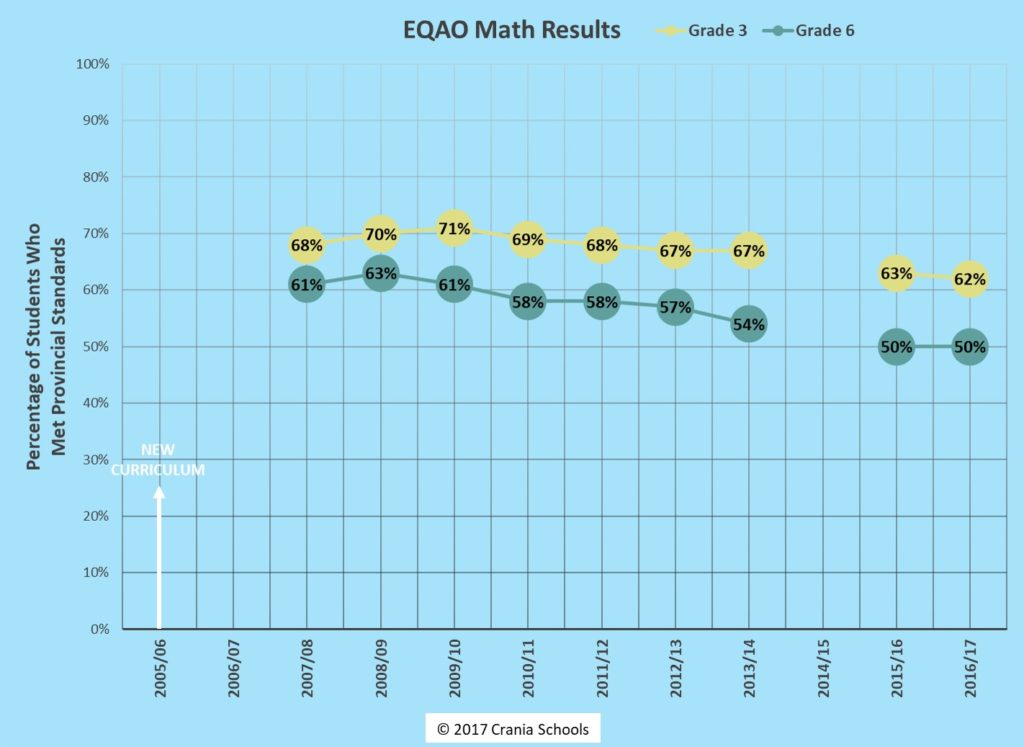
The provincial Education Equality and Accountability Office or EQAO is an independent government body that develops and oversees reading, writing and mathematics tests that Ontario students must take in Grades 3, 6, 9, and 10. See the key highlights of this year’s results below:
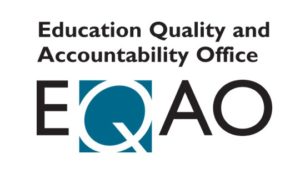
Overall EQAO Results 2017: Key Highlights and Trends
These graphs include both Primary (Gr.3 ) and Junior (Gr. 6) Divisions.
Mathematics
- Half of students fail to meet the standard in Gr. 6.
- There is a general downward trend in math for the past 7 years.
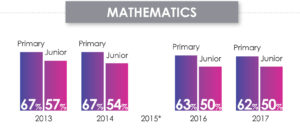 Reading
Reading
- Reading results have increased by 2% points for Gr. 3 and both age divisions have seen a general upward trend.
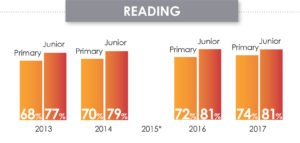 Writing
Writing
- Writing results have decreased by 1% points in both age divisions.
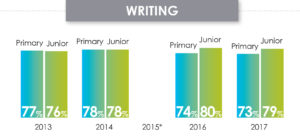
Grade 9 Mathematics
- The majority of students in “Academic” Math courses meet the standard.
- More than half of “Applied” math students fail to meet the provincial standard.
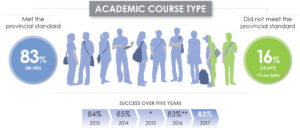
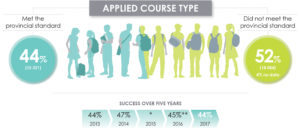
What are the implications of these results?
- Students that do not meet the provincial math standards in early years, are much less likely to catch up in Gr. 6 and especially not in high school. Academic math courses are required to apply to many competitive and STEM-based university degrees.
- Small gaps in math performance can lead to substantial difference in further education and future career options.
Parents and Educators Reactions and Criticism:
Many parents have been echoing the same concern for years and blame the education system and educators. Some parents say to do away with the discovery math instruction method completely as the downward trend in math performance continues.
Educators say that more time is necessary to see positive results from the new curricula.
At the end of the day, more children now than 7 years ago, are struggling in math at even earlier ages. In Grade 6 and Gr 9, the gap widens between students that succeed in math and the ones that are behind.
What can parents do to help their child’s math?
- Take matters into your own hands.
- Don’t wait for promises from education ministers and get your child practicing math after school to catch up or further excel in their math performance.
- Start early to fill gaps in understanding to solidify concepts.
- If your child’s grades are slipping or their confusion grows when doing math, it is time to get outside help from dedicated after-school programs or tutors.
- Building children’s confidence in math early-on is crucial.
- The way to build confidence is to practice it, have fun, and engage in the work. Getting tutoring or enrolling in math programs will allow children to learn new concepts in multiple and effective teaching approaches.
- This outside help will allow your child to go at their own pace rather than waiting for classmates and becoming bored.
- The key to long-term confidence is for your child to SEE RESULTS and improvements in math.
- How to see results? Use programs, math education resources, or tutors that are researched-backed and have good reviews!
- If your child doesn’t respond to the math exercises at school or progresses slowly, know that your child can do much better.
- There are online social media groups that share these tips such as KW Parents for Education on Facebook and even the resources that we’ve recommended that are tried and tested to get kids engaged and actually learning math.
Check out our 7-step Math Curriculum, Robotics and Coding Courses, and Enrichment Math Programs.
Also, call or email us for a Free Math Assessment for your child at 519-781-8810 or info@crania-schools.com.
Make sure to like our social media pages and share to help spread the word and get the message out! Comment to let us know if this helped you and if you want more content like this.
Sources:
http://www.cbc.ca/news/canada/toronto/half-ontario-students-fail-math-1.4268616
http://www.eqao.com/en/about_eqao/media_room/facts_and_figures/Pages/infographic-2017-elementary-results.aspx
http://www.eqao.com/en/about_eqao/media_room/facts_and_figures/Pages/infographic-2017-grade9-results.aspx
http://www.eqao.com/en/assessments/results/communication-docs/provincial-report-highlights-elementary-2017.pdf
http://www.eqao.com/en/assessments/results/communication-docs/provincial-report-highlights-grade9-2017.pdf
Book Lists by Age
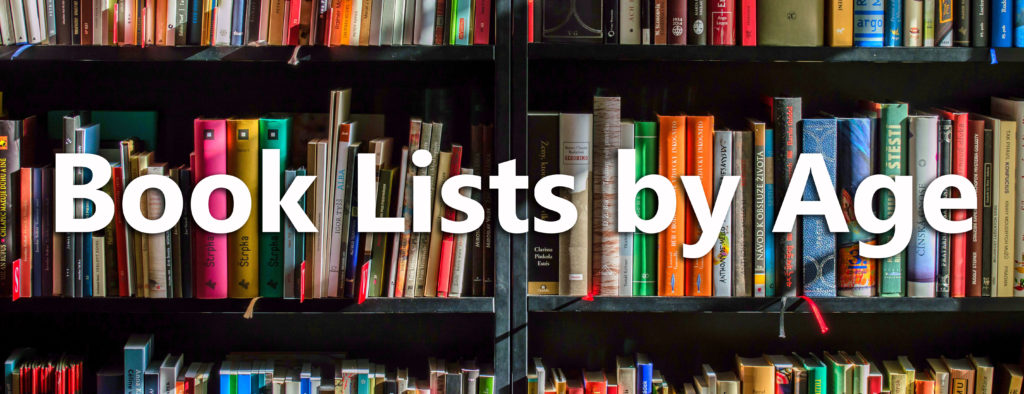
Have you checked many books off of your summer reading list? Have your kids kept up with their reading this summer? Reading through the summer can help reduce summer learning loss.
Don’t worry if your kids haven’t read as many books as you planned. Now is a great time to get them reading with our list of books by age level! These must-read books are a mix of classics and contemporary works that your kids can read.
Benefits of your kids reading books:
- Increase reading comprehension
- Advance their vocabulary
- Improve concentration
- Understand cultural references
- Prepare for future English classes
- Relax and enjoy reading

Age 3-5 (Parents will enjoy reading these to your kids)
- Alexander and the Terrible, Horrible, No Good, Very Bad Day – by Judith Viorst
- Amelia Bedelia – by Peggy Parish
- Beezus and Ramona – by Beverly Cleary
- The Cat in the Hat – by Dr. Seuss
- Clifford the Big Red Dog – by Norman Bridwell
- Curious George – by Hans Augusto Rey
- The Giving Tree – by Shel Silverstein
- Green Eggs and Ham – by Dr. Seuss
- Horton Hatches the Egg – by Dr. Seuss
- How the Grinch Stole Christmas – by Dr. Seuss
- The Lorax – by Dr. Seuss
- Love You Forever – by Robert Munsch
- Oh, the Places You’ll Go – by Dr. Seuss
- The Paper Bag Princess – by Robert Munsch
- The Polar Express – by Chris Van Allsburg
- The Tale of Peter Rabbit – by Beatrix Potter
- The True Story of the Three Little Pigs – by Jon Scieszka
- Very Hungry Caterpillar Board Book – by Eric Carle
- Winnie the Pooh – by A.A. Milne
Age 6-9
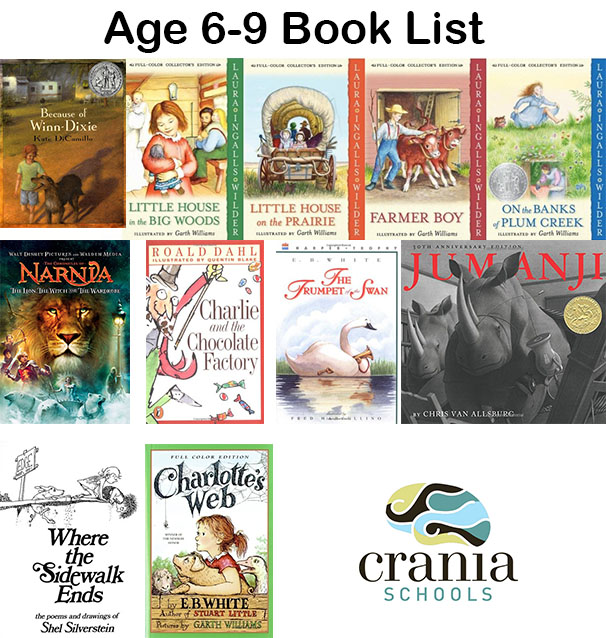
- Because of Winn-Dixie – by Kate DiCamillo
- Charlie and the Chocolate Factory – by Roald Dahl
- Charlotte’s Web – by E.B. White
- Harry Potter Series – by J.K. Rowling
- Holes – by Louis Sachar
- James and the Giant Peach – by Roald Dahl
- Jumanji – by Chris Van Allsburg
- A Light in the Attic – by Shel Silverstein
- The Lion, the Witch and the Wardrobe – by C.S. Lewis
- Little House Series – by Laura Ingalls Wilder
- A Series of Unfortunate Events – by Lemony Snicket
- The Trumpet of the Swan – by E.B. White
- The Velveteen Rabbit – by Margery Williams Bianco
- Where the Sidewalk Ends – by Shel Silverstein
Age 10-13
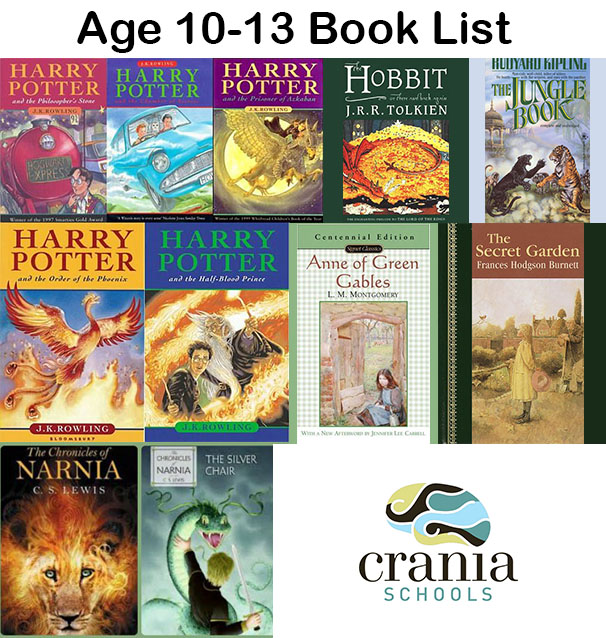
- Alice’s Adventures in Wonderland & Through the Looking-Glass – by Lewis Carroll
- Anne of Green Gables – by L.M. Montgomery
- Bridge to Terabithia – by Katherine Paterson
- A Christmas Carol – by Charles Dickens
- Fantastic Mr. Fox – by Roald Dahl
- The Giver – by Lois Lowry
- Harry Potter Series – by J.K. Rowling
- The Hobbit – by J.R.R. Tolkien
- The Jungle Book – by Rudyard Kipling
- Little House Series – by Laura Ingalls Wilder
- Narnia Series – by C.S. Lewis
- The Secret Garden – by Frances Hodgson Burnett
- Treasure Island – by Robert Louis Stevenson
- A Wrinkle in Time – by Madeline L’Engle
Print the full list by clicking on the image below.
Sources:
http://www.teachersfirst.com/read-sel.cfm
https://www.goodreads.com/list/tag/elementary
https://www.goodreads.com/list/show/98128.Best_Children_s_Classics
https://www.goodreads.com/list/show/43259.Best_series_for_Elementary_Middle_School_children
Make sure to like our social media pages and share to help spread the word and get the message out! Comment to let us know if this helped you and if you want more content like this.
10 FREE Educational Resources
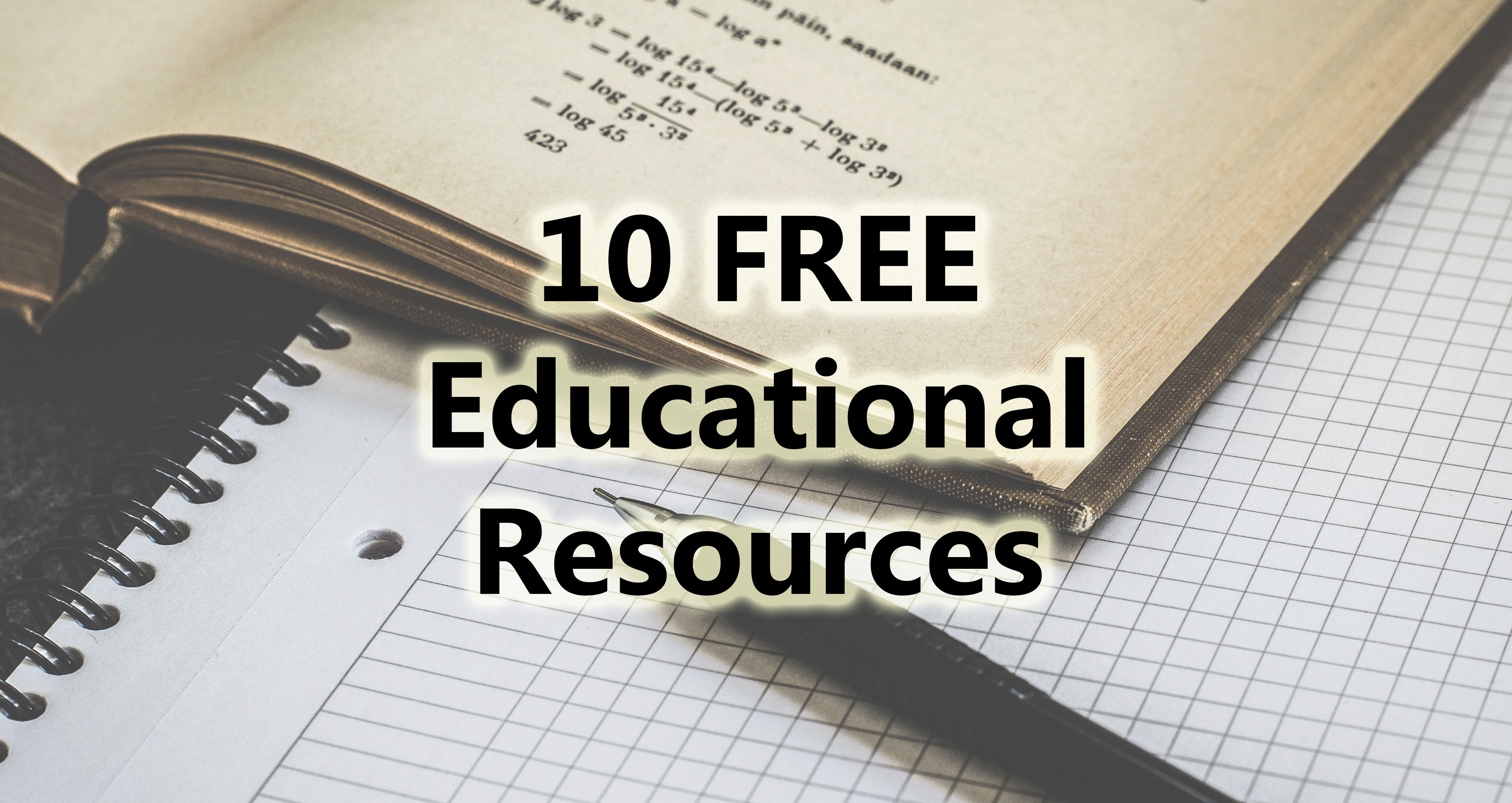
How we learn has changed a lot over the last couple of decades. While institutional-based learning is still mainstream, there is more focus than ever on learning at home and using the Internet for the glorious information tool that it is! Many online resources are gamified and research shows that this increases learning amongst users.
The Internet provides access to many wonderful resources but how does a parent know which ones to choose for their children?
We’ve compiled a list of effective FREE resources you can access right now to get your kids excited to learn without frustrating your kids or yourself!
If you want faster access to FREE educational resources like these, join the KW Parents for Education Facebook Group now. It’s an online community for parents to share ideas, resources, tips and any useful information to enhance the education of the next generation.
We wanted resources that are:
- accessible
- engaging
- easy-to-follow and easy to understand
- get the best bang for your buck, in terms of time
Resources
- khanacademy.org
The most well-known online tutor with over thousands of lessons in all subjects and levels. For math, you can pick lessons by subject, grade level, and test prep for older students. - k5learning.com
Looking for some worksheets to print out for your child? Try this site to get math worksheets for grades 1-6. - prodigygame.com
This is a popular one with schools and kids. It incorporates math with a video game. If your kids are into games, this one’s for you! You’ll need to create an account to use it. - dltk-teach.com
Get your kids writing early and improve their penmanship with these tracers. Site can be confusing to navigate but lots of great resources. I’ve been using their tracers for years! - pbskids.org
Do your kids like their TV characters? Here’s a great site that incorporates learning with their favorite shows. Note: the videos don’t work in Canada. - coolmath.com
Coolmath.com is a great hub for kids to watch lessons for math concepts and get access to fun math games. The site is affiliated with coolmath-games.com (a teacher favorite and popular with the kids) and coolmath4kids.com. - jumpstart.com
Jumpstart is great for picking math worksheets, plans or activities that your kids can do at home. It’s great for filling in gaps and areas your child struggles with. My favorites are the Homemade Ruler and the Math Sticks. Hours of Math fun! - mpower.tvo.org
For parents with younger kids (J.K. to Grade 6)!
This site is an Ontario-curriculum based online game to enforce basic math skills and is fun for your kids! - jr.brainpop.com
You will find lots of quality educational content. Some of the content requires a subscription but still plenty of free stuff! - earth.google.com
Use this tool for easy exploration of our world. Kids love to travel around the globe and explore different countries. It’s extremely easy to use and kid friendly.
Don’t forget to like our social media pages. Comment to let us know if this helped you and if you want more pages like this. Share to help spread the word and get the message out!
Back-to-School Shopping List by Grade

In the midst of long, warm summer days filled with visits to the beach and sipping umbrella-ed drinks by the poolside, it’s not likely many of us are thinking of going back to the S place. But to avoid the last minute rush and missing out on what your child needs, now is a good time to start preparing for the big return. Make sure you don’t miss anything by using our ultimate back-to-school shopping checklists! These lists are guidelines and you generally only need to buy what your child uses and what is not already provided by your school.
We made it convenient for you to print the list you want by grade level so you can take it on your next trip; just click the image. If you know someone who could use a list too, please share!
Happy Shopping!
JK – Grade 3
Grades 4-6
Grades 7-8
Grades 9-12
Make sure to subscribe to our newsletter and follow us on Facebook and Twitter to learn hear more about topics like this!
Infographic: Signs Your Child is Gifted

Check out crania-schools.com to see a wide variety of programs in Math, and Coding/Robotics for Kids.
Subscribe to our Newsletter for insider information, resources and upcoming promotion exclusives!
The 6 Benefits Early Music Education has on a Child’s Brain Development
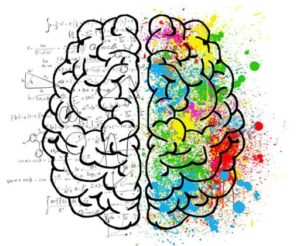
Musicians’ brains look and function differently
There are a large number of scientific studies that prove that Early Music Education in children can…
- improve their cognitive function
- help their memory
- help them to learn language
- moderate their emotional states
- help their brains to be healthier
- help solve complex problems

How does early music education greatly improve brain development?
Learning music is like a full body workout because it works the entire brain. It works three different parts of the brain: the motor, visual, and auditory cortices.
Music helps us to become comfortable with discomfort, and learning is uncomfortable. Music increases our tolerance to power through difficult problems and helps us to solve problems creatively.
Think on a bigger scale:
Music education can have a big impact on our society.
Imagine having a generation of children with early exposure to music with higher IQ and cognitive capability.
Imagine children with learning disabilities, ADHD, and kids struggling in math being able to bridge the gaps in their learning by having a healthier and more effective brain!
All this data was extracted from “What if every child had access to music education from birth – Anita Collins”. Check the full TED talk video below to hear the details of how music education improves brain development and the implications of having a smarter generation in our society.
Video: What if every child had access to music education from birth?
Make sure to subscribe to our newsletter and follow us on Facebook and Twitter to learn hear more about topics like this!
Opinions on the Ontario Math Curriculum, Falling Test Scores, and Experts’ advice
 There is increasing criticism on the fairly-new Ontario math curriculum which focuses on teaching through discovery-based learning and delaying arithmetic to later years.
There is increasing criticism on the fairly-new Ontario math curriculum which focuses on teaching through discovery-based learning and delaying arithmetic to later years.
We compiled a list of News Articles with Summaries highlighting the differing opinions on the curriculum by parents, teachers, and math and education experts from local to international news. Let’s hear what the experts have to say!
News Article Summaries
Article 1: Ontario’s math system is broken. So why isn’t the government fixing it?
- EQAO 2015/2016 math results should give parents reason to worry. The math standard for the Grade 3 division fell from 68% to 63% and is worse for the Grade 6 students, where only 50% met the provincial standard.
- This isn’t new News. Parents and mathematicians have been calling for change since 2011.
- Experts say the policy changes are to blame because the discovery-based learning is confusing.
- There is a misconception that basic skills and deliberate practice interfere with understanding math.
- Math education experts blame the curriculum, provincial ministry and lack of parents’ involvement.
- ½ of Ontario Grade 6 students failed to meet provincial standards
- The Discovery-math trend has spread across the country and teachers are unfairly blamed.
- Quote: “We have a very good tradition in North America of reading to our kids at home but how many of us do math with our kids at home?”. Math phobia exists in parents and spreads to our kids.
- The solution is to do both memorization and mastering basics while decreasing discovery math.
Article 3: Local families see hope in math despite tumbling scores
- Math scores are plummeting as students scores much lower than the Ontario average.
- Math needs to be talked about in Kitchener-Waterloo.
- Controversy with the new Discovery-Based curriculum.
Article 4: Half of Grade 6 students in Ontario failed to meet provincial math standard
- There has been a continuous decline in math test scores over the past seven years.
- Math educators are divided. They are debating whether students benefit more from traditional methods, e.g. rote learning, or a mere discovery-based problem-solving approach.
Article 5: No, teaching math the old-fashioned way won’t work
- “If you fall behind in math you stay behind.” This is why is it crucial for children to have a strong foundation in math.
- Parents blame the new curriculum of discovery based learning, claiming it’s weird and the old method is better.
- “In math, you can’t have a rule for everything. Modern curricula recognize and try to teach flexibility”
- What to do?
- Ontario should support teachers by sharing best teaching practices.
- Support students by giving more practice time.
- “Manitoba is rolling out a revised curriculum for elementary schools that explicitly require students to learn times tables, math ‘facts’ and standard algorithms.” The province is taking a step back from discovery-based learning and are explicitly using standard algorithms.
- Not going totally back to old method but to create a basic foundation at an early age
- “Don’t neglect one side in favour of another.”
Article 7: Possible reasons math scores are dropping in the US
- Children’s math scores have been declining since 2009. Possible reasons:
- “A school structure that doesn’t work with changing family life”
- “Psychotropic medication inhibits cognitive function”
- “Lack of nutrition”
Article 8: US STEM education market declines China invests heavily
- US recent political changes are compromising STEM education despite the US being the largest producer of STEM goods & services.
- However, the global education market is thriving as European and Asian students rank highest in STEM subjects.
- “Preparing today’s youth for dawning autonomous revolution is the only method for equipping the future workforce to manage the innovation that will encompass industry. And STEM-focused programs and products best cultivate the skills necessary for our children to compete against international markets.”
At Crania Schools, we have a balanced approach. In our blended learning environment, students are allowed to gain a deep understanding of mathematical concepts while mastering basic math facts.
Learn how Crania Schools and our 7-step curriculum can help your child get the benefits of a balanced approach to math education.
Stay informed by signing up Now for our Newsletter and following our social media pages!
How does Waterloo Region Rank in Math?
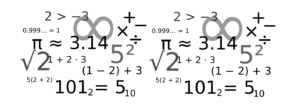
How can I check my child’s school and district board ranking?
- Check the Fraser Institute’s Annual School Report Cards (Ontario 2016 Elementary School Report Card)
- The Fraser Institute compiles lists on how Ontario elementary and secondary schools rank based on publicly-available data such as EQAO test results. The aim is to see “How well our schools are teaching our kids?” The reports identify areas of improvement and see if schools are improving.
- Ontario Average is 6/10
All 2015-2016 rankings are available at:
Elementary: http://ontario.compareschoolrankings.org/elementary/SchoolsByRankLocationName.aspx
Secondary: http://ontario.compareschoolrankings.org/secondary/SchoolsByRankLocationName.aspx
How are the current elementary schools performing in Kitchener-Waterloo? Is my child’s school falling behind?
Kitchener primary schools rank at an average of 5.6/10 which is lower than the Provincial Average.
The numbers are alarming. Approximately 1/3 of schools (16 out of 51) are ranked in the BOTTOM quartile of the entire province, with school scores go as low as 2.3/10.
Bottom five Kitchener schools:
- Rockway 2.3
- Howard Robertson 2.4
- J F Carmichael 2.8
- Trillium 3.1
- Queen Elizabeth 3.3
Waterloo primary schools’ average rank is 6.9/10 which is higher than the Provincial Average. However, several schools still fall significantly under the average.
Bottom five Waterloo schools:
- Lincoln Heights 4.2
- Cedarbrae 4.3
- Sandowne 4.7
- Keatsway 4.8
- Winston Churchill 5.0
How are the overall EQAO results?
Now, let’s compare not only between the schools but take a look at the province as a whole and the 5-year progression.
Results of the EQAO in the past 5 years have seen a downward trend in Mathematics in both the Primary (Gr. 3) Division and Junior (Gr. 6) Division. Also, there was a decrease in Writing at the Primary level last year.
The chart below shows the Percentage of All Grade 3 Students at or Above the Provincial Standard.
Primary Divison
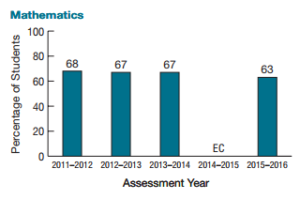
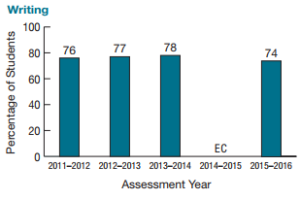
The chart below shows the Percentage of All Grade 6 Students at or Above the Provincial Standard.
Junior Division
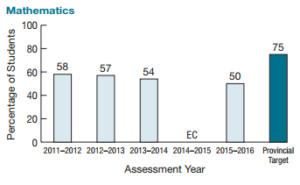
Since several schools in Kitchener and Waterloo fall below the Provincial averages coinciding with students falling behind the Provincial target results overall, more of our kids are being left behind and the gap is widening.
Full results are available at:
How are Secondary Schools in WRDSB stacking up?
Seven out of 16 secondary schools fall below the provincial average of 6/10.
However, if you look at the rankings for 2015-16, nine schools are ranked in the bottom half of the provincial rankings. That is more than half of the high schools!
In the News
Most articles try to put it gently.
With one article from CBC News titled,
“Waterloo Region District School Board EQAO results below provincial average, vows to do better”
And some articles’ standards of “scoring well” are biased and report on the well-performing schools while casually mentioning the many schools whose students are falling below the provincial standard.
Schools are not a one-stop solution!
The public education system in K-W is not a one-stop solution for your child’s learning development. Children’s learning is not limited from 8am-3pm. The learning must be extended after school and in the home for your child.
Consider this quote from a local article, “We have a very good tradition in North America of reading to our kids at home, but how many of us do math with our kids at home?”
SOLUTIONS to help bridge the gaps in your child’s education
- There are tons of resources online available for free to supplement the current school curriculum. Whether your child is looking to satisfy their curiosity and exceed in class or struggling to catch up, these resources will help their learning.
For all subjects, age levels, and completely free!
Specifically for math starting from Algebra to Calculus.
- Enroll in an after-school program with passionate teachers to develop children’s core skills such as Mathematics and to stretch new cognitive abilities through subjects like Coding and Robotics.
- Join community groups centered around supporting your children’s education. Support each other in your community by sharing ways you enhance your child’s education. Some local community groups include KW Parents for Education.
Sign-up Now for our Newsletter and follow our social media pages for pre-launch information, giveaways and future updates.
- Page 1 of 2
- 1
- 2
